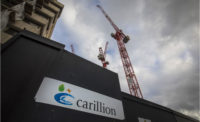Preparations have been finalized to demolish the first of four immense concrete chimneys at the historic Battersea Power Station in London. The stacks have formed the city’s dominant industrial landmark for decades.
Rising more than 100 meters, the chimneys are in poor shape and due to be replaced by exact replicas as part of a multibillion-dollar, mixed-use development that is to be centered on the giant, steel-framed, brick-clad powerplant the stacks once served.
Owned by a Malaysian consortium, the Battersea development will spread over 16 hectares along 400 m of the River Thames’ south bank, a couple of kilometers upstream of the Houses of Parliament.
In addition to the restoration work, construction is to take place in three phases during which clusters of buildings, including 3,500 homes, will rise within and around the powerplant as it undergoes an estimated $1.2-billion restoration and conversion to mixed use.
Local contactor Mace Group began work on the restoration of the plant itself in late 2013 under a contract the company values at $160 million. Restoration is “at the heart” of the entire development plan, according to Rob Tincknell, CEO of Battersea Power Station Development Co.
The first phase of new construction is being executed by London-based Carillion PLC, which a year ago secured the main contract for the 130,000-sq-m, two-building phase-one work. Construction launched last July with a groundbreaking event attended by U.K. Prime Minister David Cameron and his Malaysian counterpart, Najib Razak. Carillion values its contract at $670 million.
In the 180,000-sq-m second phase, apartments, offices, an auditorium and other facilities will be built within the restored plant by 2019. A separate contract for that work is due for award later this year.
Design of the development’s 2-million-sq-m third phase, which is to include residential, retail and leisure facilities—but which still has to secure permitting—were unveiled early this month by joint architects Gehry Partners, Los Angeles, and Foster + Partners, London.
“Our goal … has been to create a neighborhood that connects into the historic fabric of the city of London, but one that has its own identity and integrity,” noted architect Frank Gehry.
A recent survey for New London Architecture recorded about 230 buildings taller than 20 floors in planning or under construction in London. None of Battersea’s new buildings will rise above the old brick powerplant.
The 503-MW Battersea Power Station was built in two phases, the first in1929 and the second in 1944, with the fourth chimney going up in 1955.
The older portion was shut down in the mid-1970s, followed by the shutdown of the remainder of the plant eight years later. An attempt to convert the site into a theme park failed in 1989.









Post a comment to this article
Report Abusive Comment